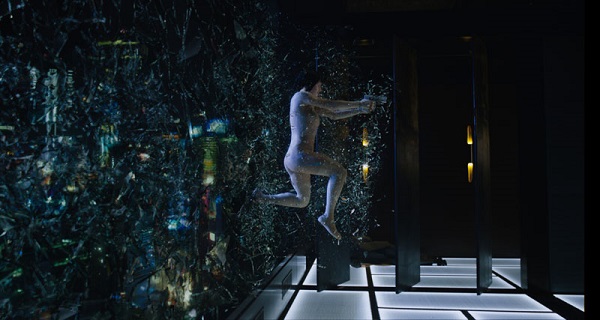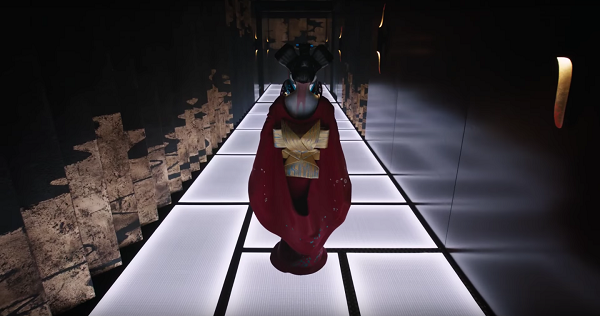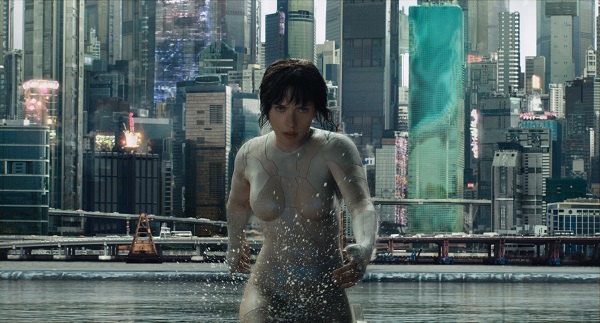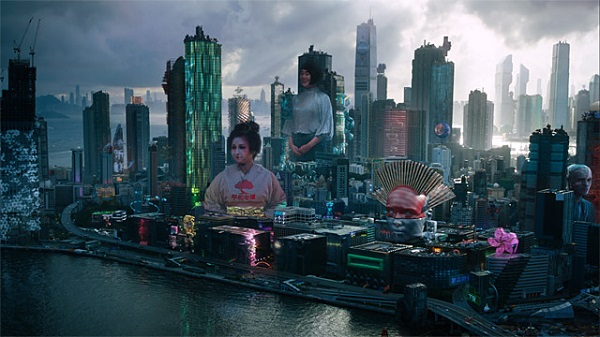Ghost in the Shell Review
"Woman or Machine?"
Based the long-running franchise
Ghost in the Shell created by Masamune Shirow; the 2017 live-action is an attempt at an American adaptation of the property. It was met with years of development hell and casting controversy.
In the future, the lines between humanity and technology blur - due to people having cybernetic enhancements. This field of science makes an even bigger leap when scientists at Hanka Robotics are able to put a human brain in a synthetic body creating The Major AKA Mira Killian (Scarlett Johansson) - an agent who can be faster and stronger than any human. She is assigned to work for the police organization Section 9 and is tasked with the mission to find a hacker called Kuze: killing scientists who work for Hanka.

Let us get the elephant in the room out the way: yes it was
controversial to cast a white actress in a role that was traditionally Japanese - even if the
anime's director Mamoru Oshii says he has no problem with the casting when he
spoke to IGN. Johansson is a talented actress - having experience playing cold and distant characters (
Her,
Under the Skin and
Lucy) and she has shown that she can
handle action scenes in the Marvel Cinematic Universe. If the filmmakers had decided to set their version of
Ghost in the Shell in a North American, European or culturally ambiguous city then the casting of a
star like Johansson would have been acceptable: but the film ends up trying to have its cake and eat it too by having Western actors in most major roles yet keeping the Asian setting. The casting decision is made even worse when there is a reveal of The Major's past.
A good portion of
Ghost in the Shell was filmed in Hong Kong, using the city's tower blocks and stores, while iconic skyscrapers like the Bank of China Building are in the background.
Ghost in the Shell even uses Japanese imaginary: early on in the film a robot assassin is dressed like a geisha, which leads to the question why remake the film with this setting but not use an East Asian cast or at least actors from East Asian heritage.

Aside from Johansson the majority of the cast were Western, including the talents of Juliette Binoche (
Chocolat), the underrated Michael Pitt, Pilou Asbæk (
Borgen) and Peter Ferdinando - both a British actor is required to play the villain even if the character is American. Any actor of other ethnicities are relegated to side characters like Danusia Samal Cockney-accented Ladriya and Chin Han as Togusa - a character who had a prominent role in the anime. The only major Asian character was the chief of Section 9, played by cult Japanese actor/filmmaker Takeshi Kitano, who weirdly only spoke Japanese when the rest of the cast spoke English.
Out of the Western cast members, Asbæk and Pitt left the best impression. Asbæk did look a lot like the anime character he was based on, Batou, a hulking, muscular man and despite his appearance is a capable officer and a good friend to The Major. Pitt played Kuze and he was mesmerizing as a glitchy individual
who has a brilliant mind but a broken body and his plot is essentially like V from
V for Vendetta.
 Ghost in the Shell
Ghost in the Shell was famously adapted into an anime film in 1995 and became a cult hit in the West. Director Rupert Sanders clearly watched the original since he attempts to replicate some of the anime's scenes: both films have opening credits where The Major gets constructed - there were scenes where an invisible Major beats up a suspect she been chasing, The Major waking up in her apartment and the scene with the dump truck has been repurposed to be an assassination attempt. There are also small references like Batou caring for a stray beagle - the anime had a motif with basset hounds because the director liked that breed of dog - although beagles are easier to train. The guns the assassins used in an early scene were similar to the ones in the anime as well as the cars.
Ghost in the Shell is Sanders' second feature film - his first being
Snow White and the Huntsman. He also has plenty of experience directing commercials, including some for the
Halo franchise. He knows how to craft a scene and
Ghost in the Shell has terrific visuals. Even with the ‘cultural appropriation’ and the use of a geisha robot during the early assassination scene, it was still a stunning sequence while Sanders’ version of the title credits could easily work as a moody music video. Sanders certainly captures the look of a dark and dank dystopia and clearly uses 1982’s
Blade Runner as a reference point - showing hologram advertising on skyscrapers, rain-covered and wet streets and dark interiors from nightclubs to offices of Section 9’s Headquarters.

This version of
Ghost in the Shell does use the basic plot idea from the original anime film where Section 9 are investigating a mysterious hacker who could be key to a great leap forward. However, the writers choose to focus the story on The Major discovering her past. This was done partly to fit a more Western/Hollywood style of narrative. The other reason is to avoid being a carbon copy of the original. My view on remakes is that
filmmakers could take the basic ideas or premise from the original property, but can then make your own story. However, Sanders wanted to reference the original film as much as possible, the writers went for a
‘who am I?’ storyline. It's the storyline that was used in
Blade Runner and like the director's cut of that film, The Major sees mysterious images that indicate that her past is not what she thinks it is. Both versions of
Ghost in the Shell share similarities to
Blade Runner regarding their themes of identity and reality and neo-noir detective story. As well as
Blade Runner there are visual references to
The Matrix (a film that was influenced by the anime) and
Inception while both also use ideas from similar sci-fi films like
A.I.: Artificial Intelligence and
Robocop - regarding humanity and robotics.
This version of
Ghost in the Shell does not have the philosophical depth of its anime predecessor, but it is fine from the point of view as a sci-fi actioner. As previously stated, Sanders knows how to craft a scene and there are solid shoot outs and fist fights. The highlights are the first shootout involving the geisha and a bunch of terrorists and The Major's fight against the spider tank near the end: being a strong recreation of a similar sequence in the anime. However, the film was hampered by a PG-13 rating: sci-fi anime has a reputation for being violent and films like
Deadpool and
Logan have shown that there is a market for R-rated sci-fi. The filmmakers also had the incredibly stupid idea to shoot one fight scene in the dark with the only light source being held by the combatants - leading to an incomprehensible fight. It might have seemed like a cool idea on the page but awful in practice.
The live-action of
Ghost in the Shell is an attempt at making a mainstream version of the story and people looking for a sci-fi actioner should be able to enjoy it on a base level while fans of the anime should appreciate the visual references. Considering some of
the bad will against this film -
Ghost in the Shell is a lot better than expected - even if it's hard to look past the racial controversy. It should get audiences in the mood for
Blade Runner 2049 later this year.
Pros
- Visually stunning
- Solid action sequences
- Fine for people new to the franchise
Cons
- Troubling filmmaking decisions that highlight the racial insensitivity
 Let us get the elephant in the room out the way: yes it was controversial to cast a white actress in a role that was traditionally Japanese - even if the anime's director Mamoru Oshii says he has no problem with the casting when he spoke to IGN. Johansson is a talented actress - having experience playing cold and distant characters (Her, Under the Skin and Lucy) and she has shown that she can handle action scenes in the Marvel Cinematic Universe. If the filmmakers had decided to set their version of Ghost in the Shell in a North American, European or culturally ambiguous city then the casting of a star like Johansson would have been acceptable: but the film ends up trying to have its cake and eat it too by having Western actors in most major roles yet keeping the Asian setting. The casting decision is made even worse when there is a reveal of The Major's past.
A good portion of Ghost in the Shell was filmed in Hong Kong, using the city's tower blocks and stores, while iconic skyscrapers like the Bank of China Building are in the background. Ghost in the Shell even uses Japanese imaginary: early on in the film a robot assassin is dressed like a geisha, which leads to the question why remake the film with this setting but not use an East Asian cast or at least actors from East Asian heritage.
Let us get the elephant in the room out the way: yes it was controversial to cast a white actress in a role that was traditionally Japanese - even if the anime's director Mamoru Oshii says he has no problem with the casting when he spoke to IGN. Johansson is a talented actress - having experience playing cold and distant characters (Her, Under the Skin and Lucy) and she has shown that she can handle action scenes in the Marvel Cinematic Universe. If the filmmakers had decided to set their version of Ghost in the Shell in a North American, European or culturally ambiguous city then the casting of a star like Johansson would have been acceptable: but the film ends up trying to have its cake and eat it too by having Western actors in most major roles yet keeping the Asian setting. The casting decision is made even worse when there is a reveal of The Major's past.
A good portion of Ghost in the Shell was filmed in Hong Kong, using the city's tower blocks and stores, while iconic skyscrapers like the Bank of China Building are in the background. Ghost in the Shell even uses Japanese imaginary: early on in the film a robot assassin is dressed like a geisha, which leads to the question why remake the film with this setting but not use an East Asian cast or at least actors from East Asian heritage.
 Aside from Johansson the majority of the cast were Western, including the talents of Juliette Binoche (Chocolat), the underrated Michael Pitt, Pilou Asbæk (Borgen) and Peter Ferdinando - both a British actor is required to play the villain even if the character is American. Any actor of other ethnicities are relegated to side characters like Danusia Samal Cockney-accented Ladriya and Chin Han as Togusa - a character who had a prominent role in the anime. The only major Asian character was the chief of Section 9, played by cult Japanese actor/filmmaker Takeshi Kitano, who weirdly only spoke Japanese when the rest of the cast spoke English.
Out of the Western cast members, Asbæk and Pitt left the best impression. Asbæk did look a lot like the anime character he was based on, Batou, a hulking, muscular man and despite his appearance is a capable officer and a good friend to The Major. Pitt played Kuze and he was mesmerizing as a glitchy individual who has a brilliant mind but a broken body and his plot is essentially like V from V for Vendetta.
Aside from Johansson the majority of the cast were Western, including the talents of Juliette Binoche (Chocolat), the underrated Michael Pitt, Pilou Asbæk (Borgen) and Peter Ferdinando - both a British actor is required to play the villain even if the character is American. Any actor of other ethnicities are relegated to side characters like Danusia Samal Cockney-accented Ladriya and Chin Han as Togusa - a character who had a prominent role in the anime. The only major Asian character was the chief of Section 9, played by cult Japanese actor/filmmaker Takeshi Kitano, who weirdly only spoke Japanese when the rest of the cast spoke English.
Out of the Western cast members, Asbæk and Pitt left the best impression. Asbæk did look a lot like the anime character he was based on, Batou, a hulking, muscular man and despite his appearance is a capable officer and a good friend to The Major. Pitt played Kuze and he was mesmerizing as a glitchy individual who has a brilliant mind but a broken body and his plot is essentially like V from V for Vendetta.
 Ghost in the Shell was famously adapted into an anime film in 1995 and became a cult hit in the West. Director Rupert Sanders clearly watched the original since he attempts to replicate some of the anime's scenes: both films have opening credits where The Major gets constructed - there were scenes where an invisible Major beats up a suspect she been chasing, The Major waking up in her apartment and the scene with the dump truck has been repurposed to be an assassination attempt. There are also small references like Batou caring for a stray beagle - the anime had a motif with basset hounds because the director liked that breed of dog - although beagles are easier to train. The guns the assassins used in an early scene were similar to the ones in the anime as well as the cars.
Ghost in the Shell is Sanders' second feature film - his first being Snow White and the Huntsman. He also has plenty of experience directing commercials, including some for the Halo franchise. He knows how to craft a scene and Ghost in the Shell has terrific visuals. Even with the ‘cultural appropriation’ and the use of a geisha robot during the early assassination scene, it was still a stunning sequence while Sanders’ version of the title credits could easily work as a moody music video. Sanders certainly captures the look of a dark and dank dystopia and clearly uses 1982’s Blade Runner as a reference point - showing hologram advertising on skyscrapers, rain-covered and wet streets and dark interiors from nightclubs to offices of Section 9’s Headquarters.
Ghost in the Shell was famously adapted into an anime film in 1995 and became a cult hit in the West. Director Rupert Sanders clearly watched the original since he attempts to replicate some of the anime's scenes: both films have opening credits where The Major gets constructed - there were scenes where an invisible Major beats up a suspect she been chasing, The Major waking up in her apartment and the scene with the dump truck has been repurposed to be an assassination attempt. There are also small references like Batou caring for a stray beagle - the anime had a motif with basset hounds because the director liked that breed of dog - although beagles are easier to train. The guns the assassins used in an early scene were similar to the ones in the anime as well as the cars.
Ghost in the Shell is Sanders' second feature film - his first being Snow White and the Huntsman. He also has plenty of experience directing commercials, including some for the Halo franchise. He knows how to craft a scene and Ghost in the Shell has terrific visuals. Even with the ‘cultural appropriation’ and the use of a geisha robot during the early assassination scene, it was still a stunning sequence while Sanders’ version of the title credits could easily work as a moody music video. Sanders certainly captures the look of a dark and dank dystopia and clearly uses 1982’s Blade Runner as a reference point - showing hologram advertising on skyscrapers, rain-covered and wet streets and dark interiors from nightclubs to offices of Section 9’s Headquarters.
 This version of Ghost in the Shell does use the basic plot idea from the original anime film where Section 9 are investigating a mysterious hacker who could be key to a great leap forward. However, the writers choose to focus the story on The Major discovering her past. This was done partly to fit a more Western/Hollywood style of narrative. The other reason is to avoid being a carbon copy of the original. My view on remakes is that filmmakers could take the basic ideas or premise from the original property, but can then make your own story. However, Sanders wanted to reference the original film as much as possible, the writers went for a ‘who am I?’ storyline. It's the storyline that was used in Blade Runner and like the director's cut of that film, The Major sees mysterious images that indicate that her past is not what she thinks it is. Both versions of Ghost in the Shell share similarities to Blade Runner regarding their themes of identity and reality and neo-noir detective story. As well as Blade Runner there are visual references to The Matrix (a film that was influenced by the anime) and Inception while both also use ideas from similar sci-fi films like A.I.: Artificial Intelligence and Robocop - regarding humanity and robotics.
This version of Ghost in the Shell does not have the philosophical depth of its anime predecessor, but it is fine from the point of view as a sci-fi actioner. As previously stated, Sanders knows how to craft a scene and there are solid shoot outs and fist fights. The highlights are the first shootout involving the geisha and a bunch of terrorists and The Major's fight against the spider tank near the end: being a strong recreation of a similar sequence in the anime. However, the film was hampered by a PG-13 rating: sci-fi anime has a reputation for being violent and films like Deadpool and Logan have shown that there is a market for R-rated sci-fi. The filmmakers also had the incredibly stupid idea to shoot one fight scene in the dark with the only light source being held by the combatants - leading to an incomprehensible fight. It might have seemed like a cool idea on the page but awful in practice.
The live-action of Ghost in the Shell is an attempt at making a mainstream version of the story and people looking for a sci-fi actioner should be able to enjoy it on a base level while fans of the anime should appreciate the visual references. Considering some of the bad will against this film - Ghost in the Shell is a lot better than expected - even if it's hard to look past the racial controversy. It should get audiences in the mood for Blade Runner 2049 later this year.
This version of Ghost in the Shell does use the basic plot idea from the original anime film where Section 9 are investigating a mysterious hacker who could be key to a great leap forward. However, the writers choose to focus the story on The Major discovering her past. This was done partly to fit a more Western/Hollywood style of narrative. The other reason is to avoid being a carbon copy of the original. My view on remakes is that filmmakers could take the basic ideas or premise from the original property, but can then make your own story. However, Sanders wanted to reference the original film as much as possible, the writers went for a ‘who am I?’ storyline. It's the storyline that was used in Blade Runner and like the director's cut of that film, The Major sees mysterious images that indicate that her past is not what she thinks it is. Both versions of Ghost in the Shell share similarities to Blade Runner regarding their themes of identity and reality and neo-noir detective story. As well as Blade Runner there are visual references to The Matrix (a film that was influenced by the anime) and Inception while both also use ideas from similar sci-fi films like A.I.: Artificial Intelligence and Robocop - regarding humanity and robotics.
This version of Ghost in the Shell does not have the philosophical depth of its anime predecessor, but it is fine from the point of view as a sci-fi actioner. As previously stated, Sanders knows how to craft a scene and there are solid shoot outs and fist fights. The highlights are the first shootout involving the geisha and a bunch of terrorists and The Major's fight against the spider tank near the end: being a strong recreation of a similar sequence in the anime. However, the film was hampered by a PG-13 rating: sci-fi anime has a reputation for being violent and films like Deadpool and Logan have shown that there is a market for R-rated sci-fi. The filmmakers also had the incredibly stupid idea to shoot one fight scene in the dark with the only light source being held by the combatants - leading to an incomprehensible fight. It might have seemed like a cool idea on the page but awful in practice.
The live-action of Ghost in the Shell is an attempt at making a mainstream version of the story and people looking for a sci-fi actioner should be able to enjoy it on a base level while fans of the anime should appreciate the visual references. Considering some of the bad will against this film - Ghost in the Shell is a lot better than expected - even if it's hard to look past the racial controversy. It should get audiences in the mood for Blade Runner 2049 later this year.